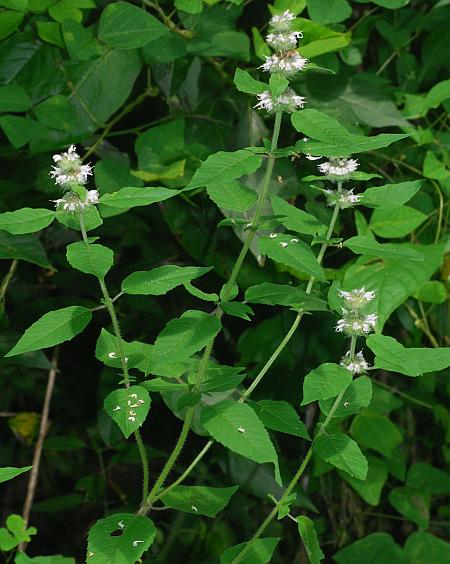Blephilia hirsuta (Pursh) Benth.
Wood Mint

Native
CC = 7
CW = 3
MOC = 50
© SRTurner
Blephilia hirsuta (Pursh) Benth.Wood Mint | |
 |
Native CC = 7 CW = 3 MOC = 50 |
© SRTurner |
|
Family - Lamiaceae Habit - Rhizomatous perennial forb with fibrous roots. Entire plant with strong minty fragrance. Stems - Erect, to 1.2 m, usually with spreading to ascending branches (especially late in season), 4-angled, single or multiple from base, moderately to densely pubescent with spreading hairs.
Leaves - Opposite, decussate, petiolate. Blades typically ovate, to 8 cm, toothed, the upper surface glabrous or sparsely pubescent with short, fine hairs, the undersurface sparsely to moderately pubescent with short, fine hairs, sometimes also with sparse longer hairs along the main veins. Petioles to 2.5 cm long, hirsute.
Inflorescence - Terminal spikes consisting of 1-5 dense, headlike clusters that are noticeably separate along the axis, each with numerous flowers, these sessile or nearly so, subtended by a pair of leaflike bracts and an involucre of conspicuous bractlets, these lanceolate, 6-10 mm long, with spreading hairs on the margins.
Flowers - Calyces zygomorphic, symmetric at the base, more or less cylindric, the tube strongly 13-ribbed, glabrous in the mouth, hairy externally, 2-lipped, the lobes shorter than to about as long as the tube, the upper lip 3-lobed, noticeably longer than the 2-lobed lower lip, the lobes narrowly triangular. Corollas zygomorphic, white with purplish spots, the outer surface moderately to densely pubescent with fine, spreading hairs, the inner surface glabrous, the tube funnelform, to 8 mm, relatively shallowly 2-lipped, the upper lip shallowly 2-lobed, slightly concave to spreading to recurved, the lower lip more or less straight to slightly spreading, 3-lobed. Central lobe of lower lip thin, with parallel margins, emarginate to shallowly lobed at apex, longer than lateral lobes. Stamens 2, initially hidden under the upper corolla lip, but becoming exserted at maturity. Filaments white, glabrous, fused near apex of corolla tube, 6 mm long. Anthers small, the connective very short and inconspicuous, the pollen sacs 2, appearing more or less sessile and spreading from the filament tip, pink or purplish-tinged to white or pale yellow. Ovary deeply lobed, the style appearing lateral to nearly basal from a deep apical notch. Style exserted, unequally 2-branched at the tip, 1 cm long, glabrous, white. Stigma 2-lobed.
Fruits - Dry schizocarps, separating into 4 nutlets, these 0.9-1.2 mm long, oblong-obovoid, the surface tan to reddish brown, glabrous, unevenly roughened or pebbled. Flowering - May - September. Habitat - Bottomland and mesic forests, bluff bases, streambanks. Origin - Native to the U.S. Lookalikes - Blephilia ciliata. Other info. - This plant is most common in the southeastern half of Missouri, and occurs throughout the U.S. Midwest and into Canada. It is typically a bottomland species, favoring much moister and more shaded habitats than its sibling B. ciliata. Other distinguishing features relative to that species are longer leaf petioles, flowers which are mostly white, a taller and more branched habit, and fragrance which is strongly minty. Although aroma is a subjective character, it is this author's opinion that B. hirsuta has a stronger and more pleasant fragrance than B. ciliata, in opposition to the reversed assertion in Yatskievych's Flora of Missouri. The plant is a favorite among the local insect population, and some authors have also noted that it is hard to find an individual which has not been browsed. Photographs taken off Northwood Rd., Platte County, MO., 6-25-00, in the Ozark Scenic Riverways, Shannon County, MO., 6-28-03, and in the Skyline Wildlife Management Area, AL., 6-25-05 (DETenaglia); also at Shaw Nature Reserve, Franklin County, MO, 6-20-2012, and Weldon Spring Conservation Area, St. Charles County, MO, 7-5-2015 (SRTurner). |